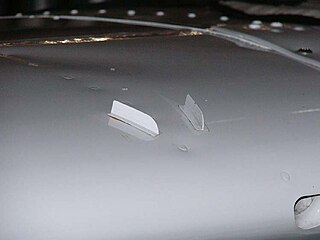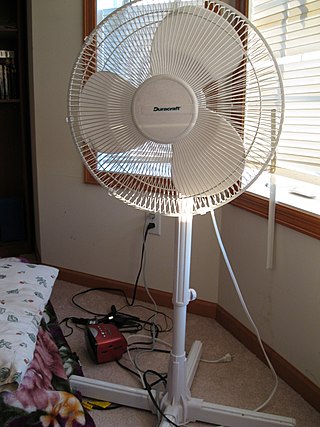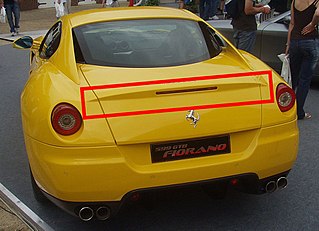
Wind tunnels are machines where an object is held stationary inside a tube, and air is blown around it to study the interaction between the object and the moving air. They are used to test the aerodynamic effects of aircraft, rockets, cars, and buildings. Different wind tunnels range in size from less than a foot across, to over 100 feet (30 m), and can have air that moves at speeds from a light breeze to hypersonic velocities.

A vortex generator (VG) is an aerodynamic device, consisting of a small vane usually attached to a lifting surface or a rotor blade of a wind turbine. VGs may also be attached to some part of an aerodynamic vehicle such as an aircraft fuselage or a car. When the airfoil or the body is in motion relative to the air, the VG creates a vortex, which, by removing some part of the slow-moving boundary layer in contact with the airfoil surface, delays local flow separation and aerodynamic stalling, thereby improving the effectiveness of wings and control surfaces, such as flaps, elevators, ailerons, and rudders.

Downforce is a downwards lift force created by the aerodynamic features of a vehicle. If the vehicle is a car, the purpose of downforce is to allow the car to travel faster by increasing the vertical force on the tires, thus creating more grip. If the vehicle is a fixed-wing aircraft, the purpose of the downforce on the horizontal stabilizer is to maintain longitudinal stability and allow the pilot to control the aircraft in pitch.
A Formula One car or F1 car is a single-seat, open-cockpit, open-wheel formula racing car with substantial front and rear wings, and an engine positioned behind the driver, intended to be used in competition at Formula One racing events. The regulations governing the cars are unique to the championship and specify that cars must be constructed by the racing teams themselves, though the design and manufacture can be outsourced. Formula One cars are the fastest cars in the world around a race track, owing to very high cornering speeds achieved through the generation of large amounts of aerodynamic downforce. Due to the amount of braking force and the total cornering envelope of a Formula One car, Formula One drivers experience frequent lateral g-loadings in excess of five g and peak cornering forces of up to seven lateral g.
In fluid dynamics, a Kármán vortex street is a repeating pattern of swirling vortices, caused by a process known as vortex shedding, which is responsible for the unsteady separation of flow of a fluid around blunt bodies.

A spoiler is an automotive aerodynamic device whose intended design function is to 'spoil' unfavorable air movement across a body of a vehicle in motion, usually described as turbulence or drag. Spoilers on the front of a vehicle are often called air dams. Spoilers are often fitted to race and high-performance sports cars, although they have become common on passenger vehicles as well. Some spoilers are added to cars primarily for styling purposes and have either little aerodynamic benefit or even make the aerodynamics worse.
In fluid dynamics, drag is a force acting opposite to the relative motion of any object moving with respect to a surrounding fluid. This can exist between two fluid layers or between a fluid and a solid surface.

In fluid dynamics, flow separation or boundary layer separation is the detachment of a boundary layer from a surface into a wake.

A diffuser, in an automotive context, is a shaped section of the car rear which improves the car's aerodynamic properties by enhancing the transition between the high-velocity airflow underneath the car and the much slower freestream airflow of the ambient atmosphere. It works by providing a space for the underbody airflow to decelerate and expand so that it does not cause excessive flow separation and drag, by providing a degree of "wake infill" or more accurately, pressure recovery. The diffuser itself accelerates the flow in front of it, which helps generate downforce. This is achieved by creating a change in velocity of the air flowing under the diffuser by giving it a rake angle which in turn generates a change in pressure and hence increases downforce.

The Ferrari F60 is a Formula One motor racing car, which Scuderia Ferrari used to compete in the 2009 Formula One season.
In car design, ground effect is a series of effects which have been exploited in automotive aerodynamics to create downforce, particularly in racing cars. This has been the successor to the earlier dominant aerodynamic focus on streamlining. The international Formula One series and American racing IndyCars employ ground effects in their engineering and designs. Similarly, they are also employed in other racing series to some extent; however, across Europe, many series employ regulations to limit its effectiveness on safety grounds.

The Williams FW16 is a Formula One car designed by Adrian Newey for the British Williams team. The FW16 competed in the 1994 Formula One season, with Williams winning the Constructor's Championship, and British driver Damon Hill finishing runner-up in the Drivers' Championship. It is notable as the last car to be driven by three-time world champion Ayrton Senna before his fatal accident during the 1994 San Marino Grand Prix. Its engine was a Renault RS6 3.5 V10. The team's main sponsor was Rothmans, replacing Camel Cigarettes and Canon used on the FW14 and FW15C. The car was designed around the major regulation changes that the FIA had introduced in the off-season, banning the various electronic devices that had been used by the front running cars during the preceding two seasons.

A fan is a powered machine used to create a flow of air. A fan consists of a rotating arrangement of vanes or blades, generally made of wood, plastic, or metal, which act on the air. The rotating assembly of blades and hub is known as an impeller, rotor, or runner. Usually, it is contained within some form of housing, or case. This may direct the airflow, or increase safety by preventing objects from contacting the fan blades. Most fans are powered by electric motors, but other sources of power may be used, including hydraulic motors, handcranks, and internal combustion engines.

The Williams FW30 is a Formula One racing car, designed by Williams and introduced at the start of the 2008 Formula One season. The car is largely an evolution of the previous, 2007-season, Williams model: the FW29. As with its predecessor, the FW30 is powered by engines manufactured by Toyota. The FW30 was unveiled to the public on 21 January 2008 at the Circuit de Valencia, Spain, and made its race debut at the 2008 Australian Grand Prix in the hands of 2008 Williams drivers Nico Rosberg and Kazuki Nakajima.

The Benetton B193 is a Formula One racing car with which the Benetton team competed in the 1993 Formula One World Championship. Designed by Ross Brawn and Rory Byrne, the car was powered by the latest Cosworth HBA engine in an initially-exclusive deal with Ford, and ran on Goodyear tyres. It was driven by German Michael Schumacher and veteran Italian Riccardo Patrese.

In aviation, a strake is an aerodynamic surface generally mounted on the fuselage of an aircraft to improve the flight characteristics either by controlling the airflow or by a simple stabilising effect.

The leading edge is the part of the wing that first contacts the air; alternatively it is the foremost edge of an airfoil section. The first is an aerodynamic definition, the second a structural one. As an example of the distinction, during a tailslide, from an aerodynamic point of view, the trailing edge becomes the leading edge and vice versa but from a structural point of view the leading edge remains unchanged.

The Ferrari 488 is a mid-engine sports car produced by the Italian automobile manufacturer Ferrari. The car replaced the 458, being the first mid-engine Ferrari to use a turbocharged V8 since the F40. It was succeeded by the Ferrari F8.

In automotive design, a nolder is a small aerodynamic shape integral to bodywork or to an aerodynamic attachment – e.g., a spoiler, diffuser or splitter – perpendicular to the direction of air flow travel for the purpose of further managing and refining air flow.

The Lamborghini Veneno is a limited production high performance sports car manufactured by Italian automobile manufacturer Lamborghini. Based on the Lamborghini Aventador, the Veneno was developed to celebrate Lamborghini's 50th anniversary. It was introduced at the 2013 Geneva Motor Show. When introduced, it had a price of US$4,000,000, making it one of the most expensive production cars in the world.

















